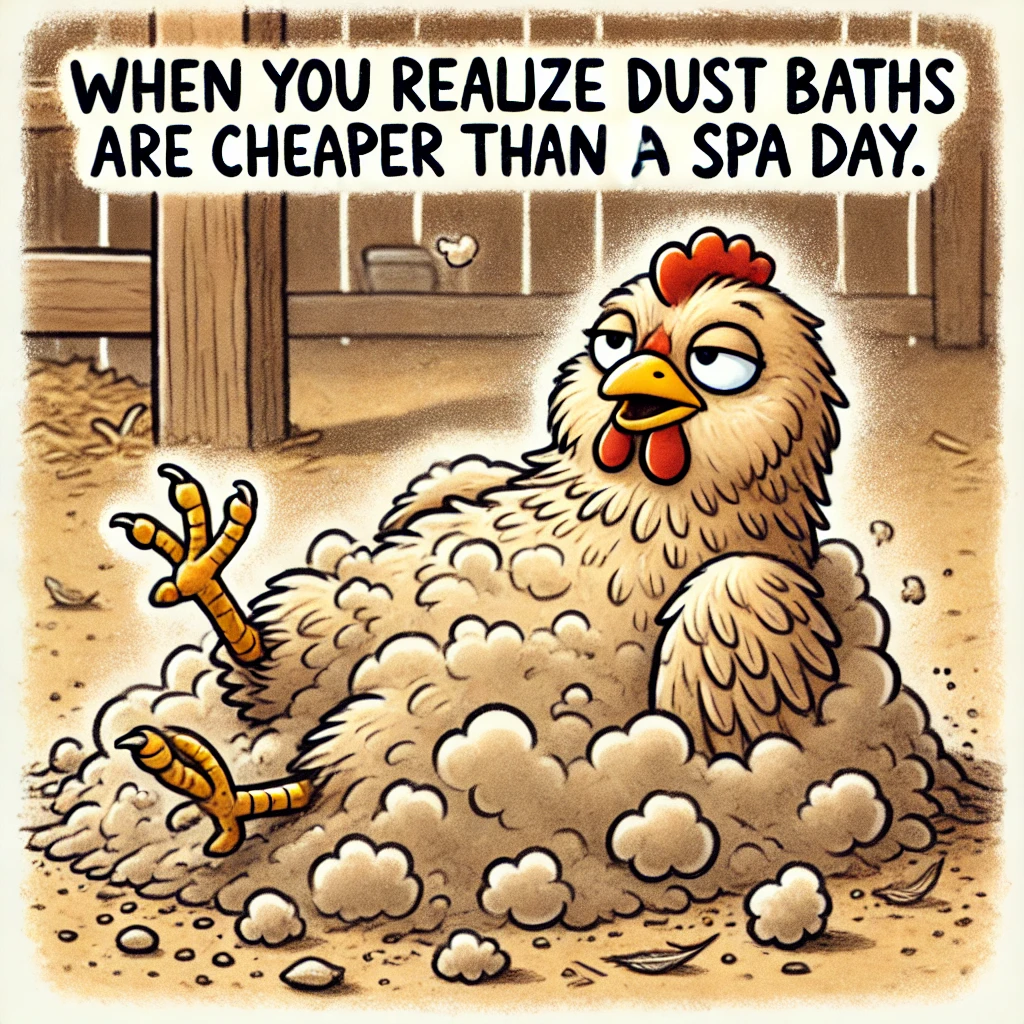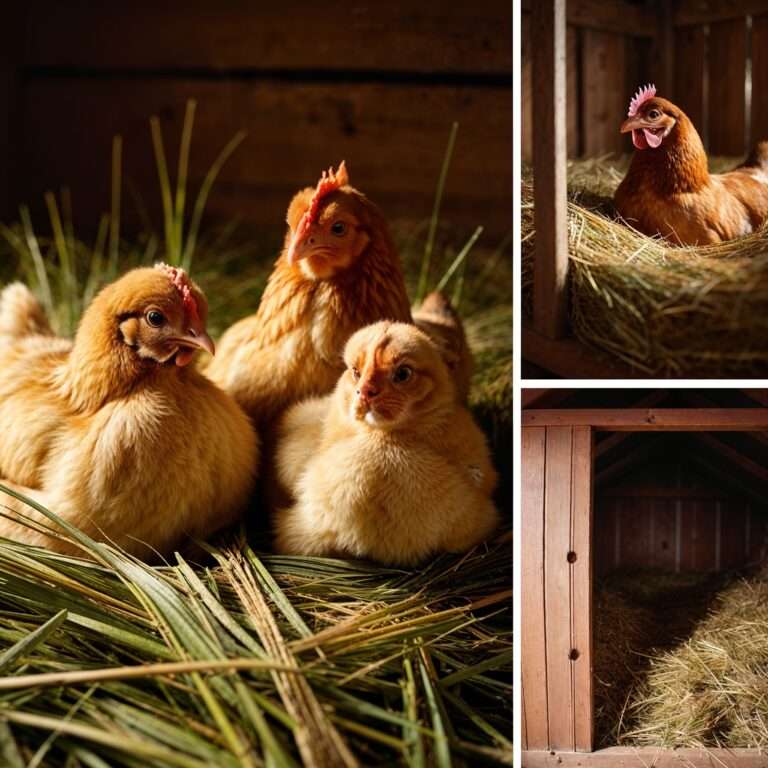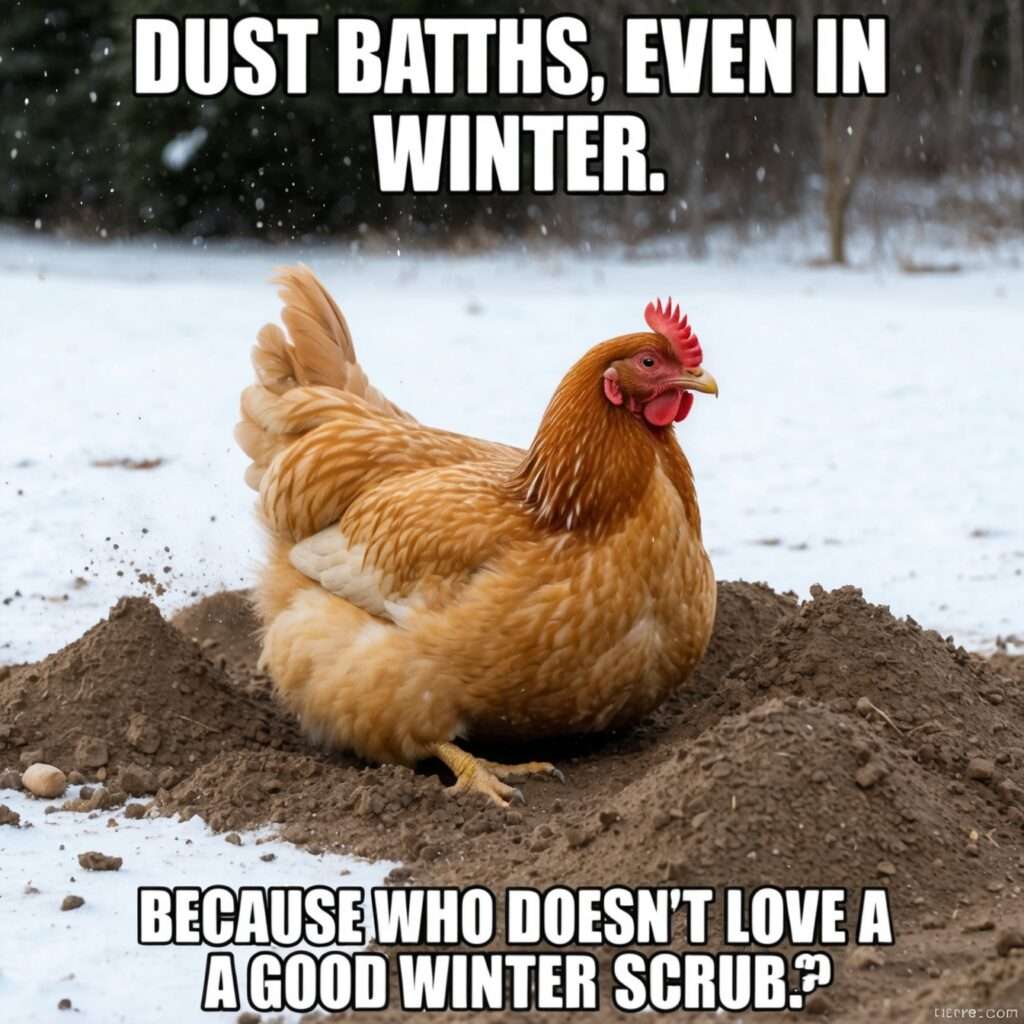
"Chickens might not know it's winter, but they sure remember their dust bath routine."
If you’ve ever kept chickens, you’ve probably noticed them scratching and rolling around in the dirt. It’s not just a quirky behavior; it’s actually a vital part of their natural hygiene routine. This behavior is known as chicken dust baths, and it serves multiple purposes, from maintaining their feathers to acting as a natural pest control method. But what exactly is a dust bath? Why do chickens love them, and how can you provide the perfect setup for your flock? In this article, we’ll explore everything you need to know about chicken dust baths, from their purpose and benefits to tips for creating an optimal dust bath environment.
What is a Chicken Dust Bath and Why Do Chickens Love Them?
A chicken dust bath is a natural behavior where chickens roll and scratch in loose dirt or dust. The chicken will dig a small hole, usually in dry, loose soil, and start to scratch at it, using their wings and feet to create a bit of a “bath” in the dirt. Once they’ve made their little dust pit, the chicken will squat down, puff their feathers, and roll around in the dust.
This behavior is more than just fun to watch—it serves several important purposes, primarily related to hygiene and pest control. When chickens roll in dust, they are effectively coating their feathers with fine particles that help absorb excess oils and clean their feathers. Dust is also a natural way to control parasites such as mites, lice, and fleas, which can otherwise infest a chicken’s plumage.
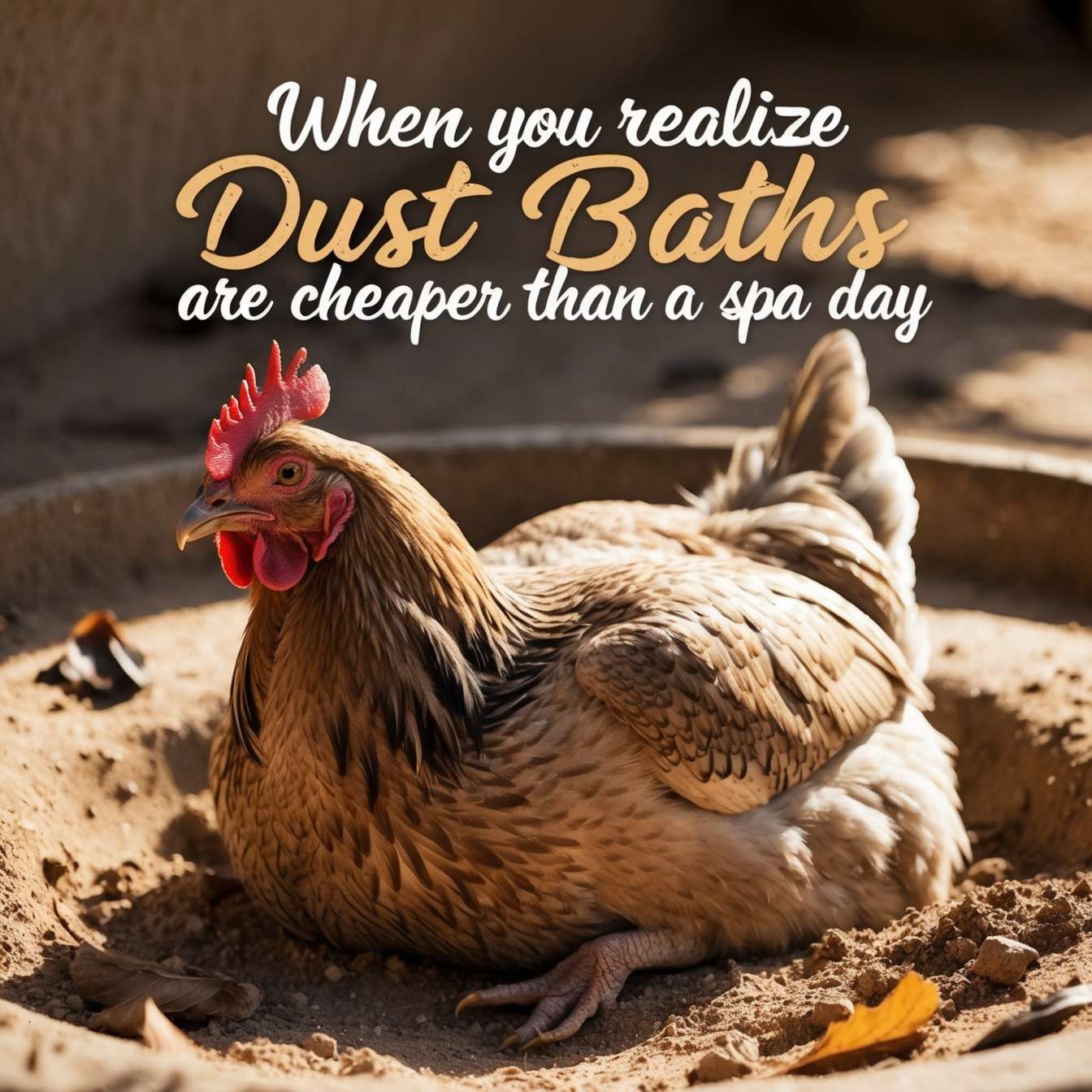
Why Do Chickens Dust Bath?
Dust bathing is an instinctive behavior that chickens have carried over from their wild ancestors. Here’s why it’s so important for their health and well-being:
- Pest Control
Dust baths help chickens manage external parasites like mites, lice, and fleas. As chickens roll around in the dust, the fine particles coat their feathers and skin, creating a barrier that suffocates or dislodges parasites. Some believe the dust helps to dry out the exoskeletons of pests, which leads to their death. - Feather Maintenance
Chickens have oil glands near the base of their tail feathers, which produce oil that helps waterproof their feathers. However, too much oil can make their feathers sticky and heavy. Dust baths help remove excess oil from their feathers, keeping them light, fluffy, and well-maintained. - Temperature Regulation
Chickens regulate their body temperature using their feathers, and dust baths can aid in this process. Rolling around in dry dirt helps them cool down by absorbing moisture and removing excess oils from their feathers. In hotter months, dust baths are especially important for keeping chickens comfortable. - Stress Relief and Social Behavior
Dust bathing is a relaxing activity for chickens, and it’s a form of social bonding as well. Chickens are social animals, and they often bath together, taking turns to roll in the dust. Dust bathing is one of the few activities where chickens will interact closely with one another, which strengthens their social structure.
How Often Should Chickens Take Dust Baths?
Chickens generally know when it’s time to take a dust bath. You’ll often see them indulging in dust baths during the warmer months, but it’s not limited to any particular season. Most chickens dust bath on a daily basis, particularly in hot or dry weather. Some of the common signs that your chickens are ready for a dust bath include:
- Warm, Dry Weather: Chickens love to dust bath when the ground is dry and warm, which is why they tend to do it more often in summer.
- After foraging: If your chickens have been foraging for bugs or scratching around, they may feel the need to clean themselves afterward.
- If they appear restless: Chickens will often look for a spot to dust bath when they are feeling bored or restless, especially if they don’t have enough space to roam freely.
If you notice that your chickens are avoiding dust baths, it could be a sign of stress or discomfort, and you may want to look into factors like temperature, pest infestations, or overcrowding.
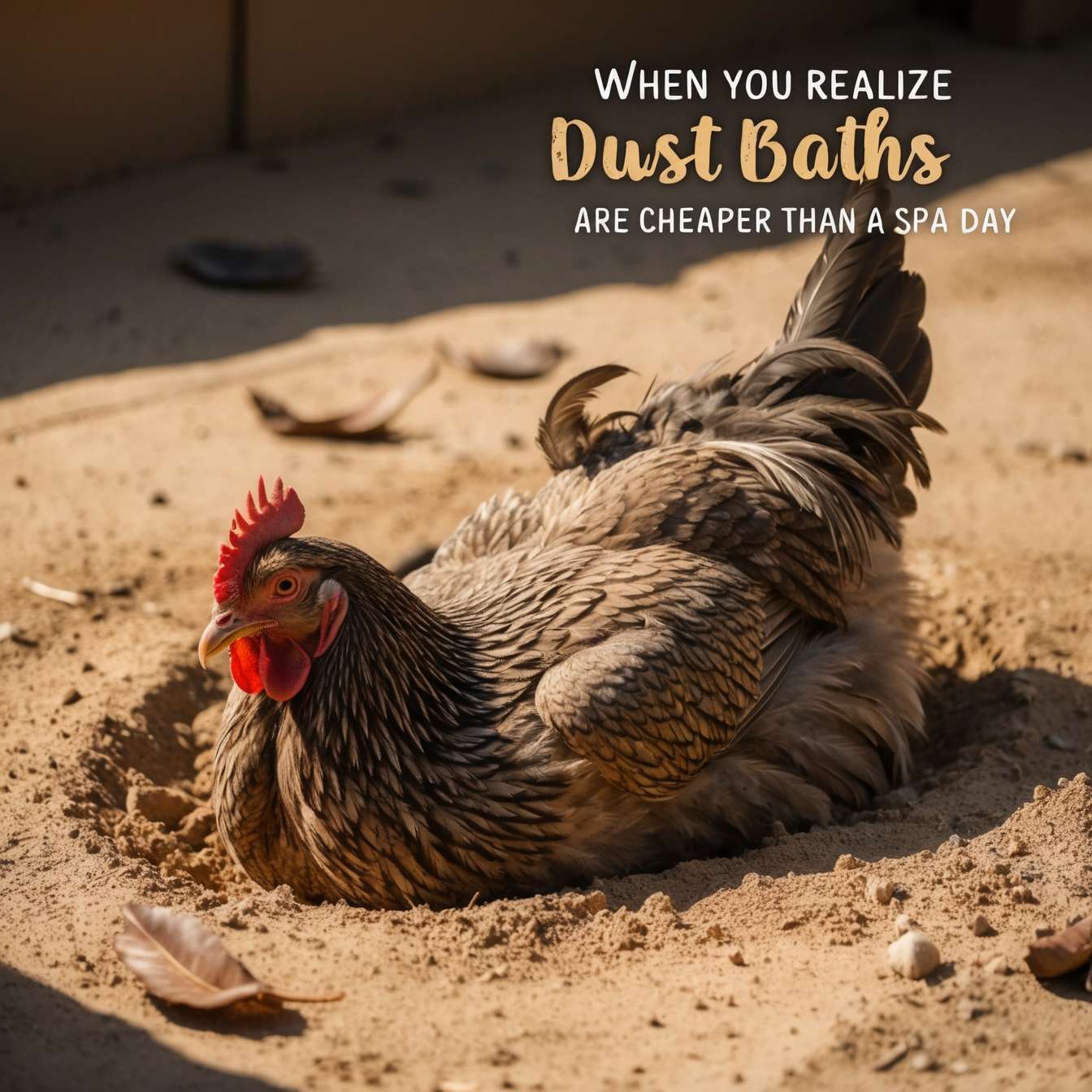
What is the Best Stuff for a Chicken Dust Bath?
Chickens are not particularly picky about what they roll around in, but they do have preferences for certain types of materials. Here’s a breakdown of some common choices and their benefits:
- Dirt
Plain old dirt or soil is the most basic and natural material chickens will use for dust bathing. It’s free and easily accessible in most environments. However, the dirt should be dry and loose to make it easy for the chickens to roll around in. - Sand
Many chicken owners prefer to offer sand for dust baths because it’s fine-grained and easy for chickens to scratch through. Sand is also great for controlling moisture, making it less likely to turn into mud after a rainstorm. - Diatomaceous Earth (Food Grade)
Food-grade diatomaceous earth is often added to dust bath mixtures as a natural pest control measure. Diatomaceous earth is a fine powder that contains fossilized remains of algae. It’s abrasive to insects, which means it can help eliminate mites and lice from your chickens’ feathers. Make sure you use food-grade diatomaceous earth, as industrial-grade versions can be harmful to both chickens and humans. - Wood Ash
Wood ash from a fireplace or wood stove can also be used for dust baths. It’s great for keeping pests at bay and provides extra minerals for your chickens. However, it’s best used in moderation, as too much ash can cause respiratory issues if inhaled in large amounts. - Shredded Leaves or Straw
Some people mix in shredded leaves, straw, or hay for a softer, more comfortable dust bath area. These materials are especially good for chickens in colder climates, as they provide extra insulation and warmth when dust bathing.

How to Make the Perfect Dust Bath for Your Chickens
Creating the perfect dust bath for your chickens is all about location and materials. Here’s how you can set up an optimal dust bath for your flock:
- Choose the Right Spot
Pick a dry, sunny spot for your dust bath area. The best places are areas that get plenty of sunshine, as the warmth will make the dust bath more appealing to your chickens. Avoid places that get too much rain, as wet dirt or mud can make dust baths less effective. - Create a Pit
Chickens love a small pit where they can roll around freely. You can dig a shallow hole (about 2 to 3 inches deep) for your chickens to enjoy. The edges of the hole should be smooth to prevent sharp edges from injuring your chickens. - Use the Right Materials
Fill the pit with a mixture of dirt, sand, diatomaceous earth, and any other materials your chickens prefer. Ensure the mixture is dry and loose for easy scratching and rolling. - Provide Enough Space
If you have a large flock, make sure to provide multiple dust bath areas so that every chicken can have a turn without fighting. Chickens love to dust bath in groups, so the more space you have, the better!
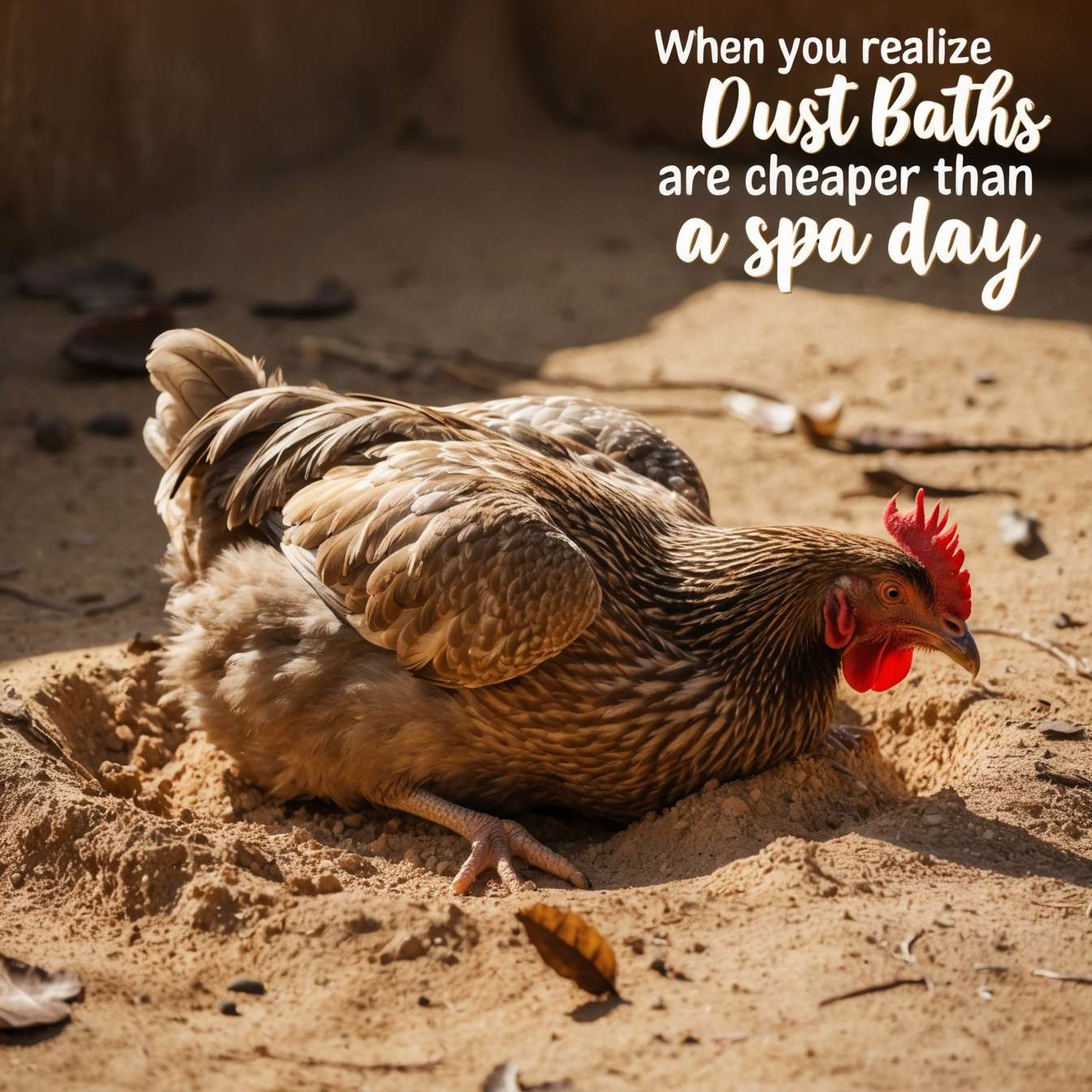
Enhancing Pest Control with Dust Baths
Dust baths naturally help to control parasites, but you can enhance their pest-fighting power by adding certain ingredients to your dust bath mixture:
- Diatomaceous Earth
As mentioned, food-grade diatomaceous earth is a natural pest control substance that works wonders for chicken dust baths. The fine particles in the diatomaceous earth scratch at the exoskeletons of pests, such as mites and lice, leading to their death. Just be cautious with the amount you use and make sure it’s food-grade. - Neem Powder
Neem powder, derived from the neem tree, is another natural pest control that chickens can benefit from. It helps repel pests like mites, lice, and fleas, and it’s safe for both chickens and humans. - Herbs in the Dust Bath
Herbs like lavender, rosemary, and mint are not only pleasant for chickens but also act as natural insect repellents. You can mix these herbs into the dust bath to further enhance pest control.
Dust Baths in Winter vs. Summer
Dust bathing is generally associated with warm weather, but it’s still important during the winter months. Here’s what you need to know about dust baths for different seasons:
- Summer: Dust baths are more common in the summer months because the weather is warm, and the ground is dry. During hot weather, chickens will dust bath to cool down, absorb excess oils, and combat pests.
- Winter: While chickens may not take dust baths as frequently in winter, it’s still important to offer a dry, sheltered spot for them to bathe in. In colder climates, you might want to add extra bedding, like straw or hay, to insulate the dust bath area. In extremely cold temperatures, chickens may not bathe as often but will still need the space to keep their feathers in good condition.
Conclusion: Why Chicken Dust Baths Are Essential for Your Flock
Dust baths are more than just a quirky habit for chickens; they are essential for their health and well-being. Not only do they help with feather maintenance, but they also provide natural pest control and are a vital part of chicken social behavior. By offering your chickens a clean, safe, and cozy dust bath area, you’re ensuring that they remain healthy, happy, and pest-free. Whether in summer or winter, a proper dust bath is a must for your flock. So, gather your materials, find a sunny spot, and let your chickens enjoy their dirt-filled spa day!
Call to Action:
Want to learn more about chickens and other quirky behaviors? Check out our other articles on chicken care and welfare,
and explore the fascinating world of poultry management!
More Reading on Paranoid Prophet
- Winter Chicken Memes and Facts: Dive deeper into the lighter side of chicken care with a collection of winter-themed chicken memes and fun facts about how chickens handle the cold. You’ll discover amusing insights and practical tips for your feathered friends in winter.
- Poultry Care & Backyard Flocks: Explore the full range of poultry care content, where you’ll find articles on optimizing your backyard flock’s health, well-being, and happiness. Whether you’re new to raising chickens or a seasoned keeper, this section provides valuable advice for every aspect of chicken ownership.
- Wheatgrass Hay & Winter Chickens: Learn about the benefits of wheatgrass hay for your chickens during the winter months. This article explores how adding wheatgrass to their diet can enhance your flock’s nutrition and overall health, helping them thrive through colder seasons.
Sources on Chicken Dust Baths
- The Chicken Chick – Chicken Dust Baths: The Ultimate Spa for Chickens
A comprehensive guide to the importance of dust baths for chickens, detailing the benefits and how chickens use them to stay healthy and clean.
URL: https://the-chicken-chick.com/chicken-dust-baths-ultimate-spa/ - Get Strong Animals – Chicken Dust Bath Featuring Coop Recuperate
A blog post that explains the benefits of dust baths for chickens, with a focus on using the right materials and creating a relaxing environment.
URL: https://www.getstronganimals.com/post/chicken-dust-bath-featuring-coop-recuperate?srsltid=AfmBOopRalyeNp-6QUFQxRLbdGn_LwtmKNlvl6alI9vMfhcPgZywsdM3 - City Boy Hens – Dust Bathing: Why Chickens Love It
This article dives into the natural behavior of dust bathing, why chickens love it, and the health benefits associated with it.
URL: https://cityboyhens.com/laying-eggs/dust-bathing/ - British Hen Welfare Trust – Chicken Dust Bath
A post that discusses the health and welfare benefits of chicken dust baths, including how they help prevent pests and keep chickens clean.
URL: https://www.bhwt.org.uk/blog/health-welfare/chicken-dust-bath/
